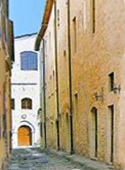
The house is on the right, just before the ex-Ospedale della SS Trinità
It now forms part of the Monastero di Sant' Anna,
which is entered from Via dei Monasteri, the parallel street to the right
[The artist Giovanni di Corraduccio, Mazzaforte seems to have owned a house and workshop here that passed to his son, Pietro di Giovanni. A third artist, Nicolò di Liberatore, l' Alunno bought a house nearby in 1460, the date of his marriage to Pietro's daughter, Caterina. He bought the land between the two in 1472 and incorporated them into a single residence and workshop. The property passed to his sons, Lattanzio di Nicolò (the fourth artist to have worked here) and Marchesio.]
The nuns of Sant' Anna acquired the property in ca. 1549. The circumstances of the acquisition are uncertain: the daughters of Lattanzio and Marchesio might have joined the community or, more probably, the nuns might have bought it from their heirs. They subsequently adapted the property to serve as their infirmary.
The three rooms of the house that preserve frescoes by Nicolò di Liberatore (see below) can be visited, either independently or as part of a visit to Sant' Anna: ring 0742 342 688 to arrange a visit.
Frescoes by Nicolò di Liberatore
Fresco (1473)
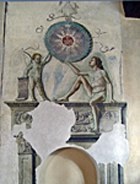
Crucifixion (15th century)
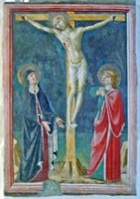
Frescoed angel (15th century)
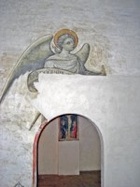
DOMINE DOCIE ME FACERE VOLUNTATEM TUAM
(Lord, let me do your will)
Graffiti (15th century)
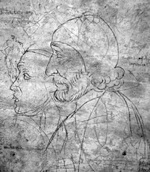
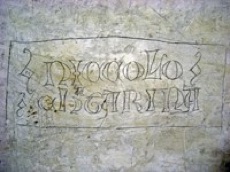
Recent restoration has revealed a large amount of graffiti (both written and sketched) under the later plaster. This includes:
-
✴the sketch illustrated here (in the third room); and
-
✴the associated inscription that identifies the figures as Nicolò di Liberatore and his wife Caterina.



